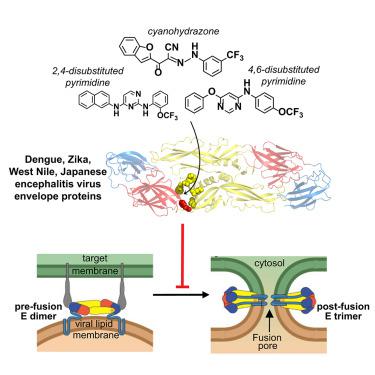当前位置:
X-MOL 学术
›
Cell Chem. Bio.
›
论文详情
Our official English website, www.x-mol.net, welcomes your feedback! (Note: you will need to create a separate account there.)
Inhibition of Flaviviruses by Targeting a Conserved Pocket on the Viral Envelope Protein.
Cell Chemical Biology ( IF 8.6 ) Pub Date : 2018-06-21 , DOI: 10.1016/j.chembiol.2018.05.011 Melissanne de Wispelaere 1 , Wenlong Lian 1 , Supanee Potisopon 1 , Pi-Chun Li 2 , Jaebong Jang 2 , Scott B Ficarro 3 , Margaret J Clark 1 , Xuling Zhu 1 , Jenifer B Kaplan 1 , Jared D Pitts 1 , Thomas E Wales 4 , Jinhua Wang 2 , John R Engen 4 , Jarrod A Marto 3 , Nathanael S Gray 2 , Priscilla L Yang 1
Cell Chemical Biology ( IF 8.6 ) Pub Date : 2018-06-21 , DOI: 10.1016/j.chembiol.2018.05.011 Melissanne de Wispelaere 1 , Wenlong Lian 1 , Supanee Potisopon 1 , Pi-Chun Li 2 , Jaebong Jang 2 , Scott B Ficarro 3 , Margaret J Clark 1 , Xuling Zhu 1 , Jenifer B Kaplan 1 , Jared D Pitts 1 , Thomas E Wales 4 , Jinhua Wang 2 , John R Engen 4 , Jarrod A Marto 3 , Nathanael S Gray 2 , Priscilla L Yang 1
Affiliation

|
Viral envelope proteins are required for productive viral entry and initiation of infection. Although the humoral immune system provides ample evidence for targeting envelope proteins as an antiviral strategy, there are few pharmacological interventions that have this mode of action. In contrast to classical antiviral targets such as viral proteases and polymerases, viral envelope proteins as a class do not have a well-conserved active site that can be rationally targeted with small molecules. We previously identified compounds that inhibit dengue virus by binding to its envelope protein, E. Here, we show that these small molecules inhibit dengue virus fusion and map the binding site of these compounds to a specific pocket on E. We further demonstrate inhibition of Zika, West Nile, and Japanese encephalitis viruses by these compounds, providing pharmacological evidence for the pocket as a target for developing broad-spectrum antivirals against multiple, mosquito-borne flavivirus pathogens.
中文翻译:

通过靶向病毒包膜蛋白上的保守口袋来抑制黄病毒。
病毒包膜蛋白是生产性病毒进入和感染起始所必需的。尽管体液免疫系统提供了针对包膜蛋白作为抗病毒策略的充分证据,但很少有药理学干预具有这种作用方式。与经典的抗病毒靶标(例如病毒蛋白酶和聚合酶)相反,一类病毒的包膜蛋白没有良好保守的活性位点,可以用小分子合理地靶向。我们以前鉴定了通过结合其包膜蛋白E抑制登革热病毒的化合物。在这里,我们证明了这些小分子抑制登革热病毒融合并将这些化合物的结合位点映射到E上的特定口袋。我们进一步证明了对寨卡病毒的抑制,西尼罗河和日本脑炎病毒,这些化合物
更新日期:2018-08-17
中文翻译:

通过靶向病毒包膜蛋白上的保守口袋来抑制黄病毒。
病毒包膜蛋白是生产性病毒进入和感染起始所必需的。尽管体液免疫系统提供了针对包膜蛋白作为抗病毒策略的充分证据,但很少有药理学干预具有这种作用方式。与经典的抗病毒靶标(例如病毒蛋白酶和聚合酶)相反,一类病毒的包膜蛋白没有良好保守的活性位点,可以用小分子合理地靶向。我们以前鉴定了通过结合其包膜蛋白E抑制登革热病毒的化合物。在这里,我们证明了这些小分子抑制登革热病毒融合并将这些化合物的结合位点映射到E上的特定口袋。我们进一步证明了对寨卡病毒的抑制,西尼罗河和日本脑炎病毒,这些化合物



























 京公网安备 11010802027423号
京公网安备 11010802027423号